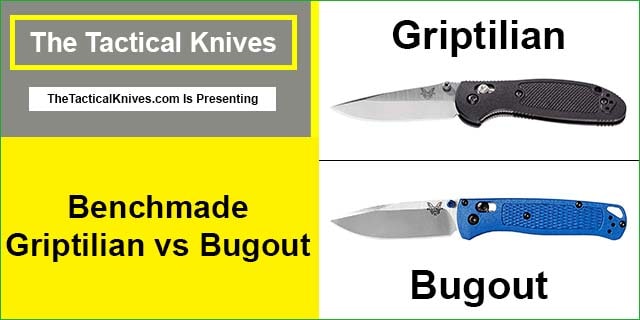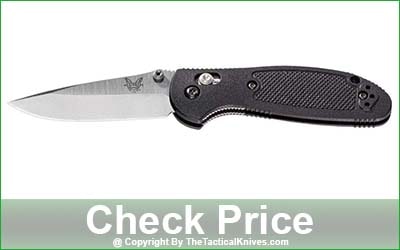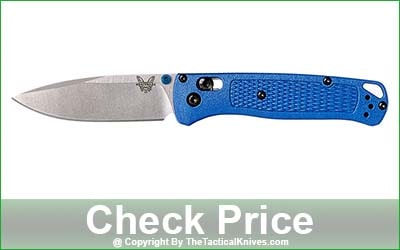Knife-lovers everywhere can be found scratching their heads when faced with a seemingly simple question: should they invest in the Benchmade Griptilian knife, or the Bugout model from the same brand?
The Griptilian pocket knife is slightly larger, heavier, stronger, extra-grippy, and above all, slightly cheaper than the Bugout.
The Bugout pocket knife, on the other hand, is a little smaller, lighter, and has a more comfortable handle than the Griptilian. Bugout’s weight and deep clip are great for EDC, but overall it’s a bit more expensive.
However, the research that goes into purchasing one can feel overwhelming. That’s why I’ve compiled a detailed comparison of the Bugout’s and Griptilian’s key features.
- Measurements
- Blade
- Handle
- Opening and Locking Mechanism
- Pocket Clip
- Pricing
- Finally – Which One to Choose and Why?
Benchmade Griptilian EDC Knife
Benchmade Bugout EDC Knife
Measurement
There is a considerable difference in the various measurements of the two knives. But the biggest difference I found was in the weight.
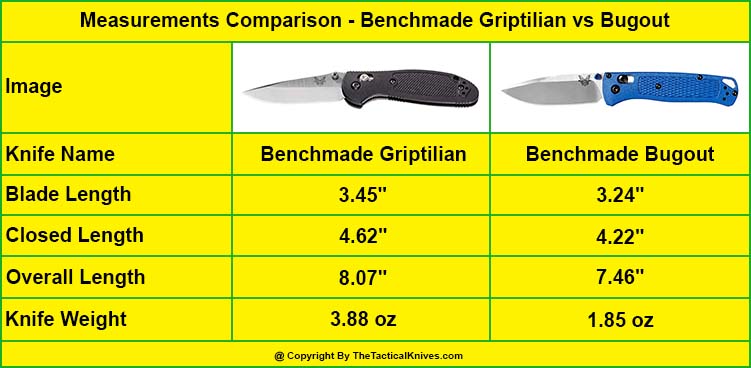
Blade Length
Both of these Benchmade pocket knives fall on the shorter end of the spectrum. The Benchmade Griptilian has a blade length of 3.45 inches, while the Bugout has a blade length of 3.24 inches.
Closed Length
While closed, the Griptilian measures in at 4.62 inches. The Bugout comes to a similar length of 4.22 inches while closed.
Overall Length
Overall, the Griptilian is 8.07 inches long. Its cousin, the Bugout, measures in at a longer 7.46 inches.
Knife Weight
The Griptilian weighs 3.88 oz, while the Bugout weighs a total of 1.85 oz. The big difference in weight between the two knives is because the Griptilian is slightly longer and has a full steel liner. On the other hand, compared to the Griptilian, the Bugout is smaller in size and has small liners.
Blade
Modern models of both knives have blades made of almost the same steel, but the Griptilian offers a lot of versatility in blade design. On the other hand, Bugout’s blade is more efficient and easy to use than Griptilian in terms of performance.
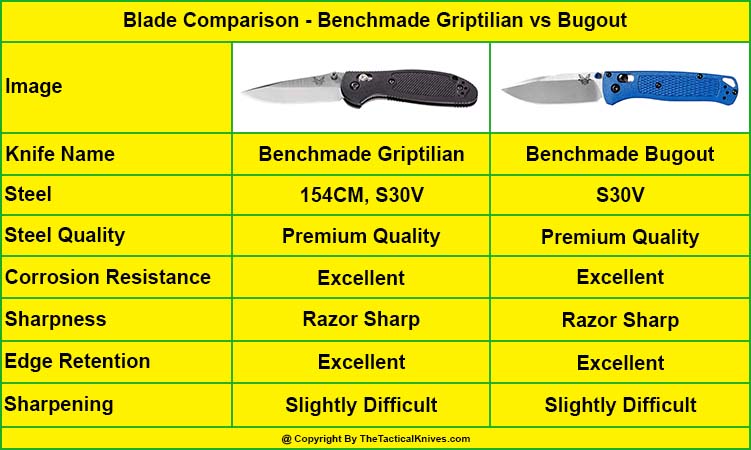
Blade Steel
Both blades are made out of premium grade S30V stainless steel – a material coveted for its durability. The blades rank equally in terms of blade steel.
It is worth noting that different versions of these two models are also made with different steel, such as 154CM steel. This 154CM reputable steel is very comparable to S30V steel, however, it won’t stay sharp for quite as long as S30V (often called a ‘supersteel’).
Blade Stain and Corrosion Resistance
Owners of either knife can rest easy when it comes to rust, as CPM-S30V steel is known for its low susceptibility to corrosion, as is 154CM steel. This means that both knives can handle being outside for extended periods of time. So whether you’re hiking or camping in the wet, rainforest or marine area, these knives are up to the task!
Blade Shape
The Griptilian’s blade is not as reputed for its appearance as the Bugout’s, but its shape is still convenient. The knife is available in sheepsfoot, tanto, and drop-point shapes. Its drop point is a little different from the Bugout’s, as it has a neat clip point feature at the top. The Griptilian has a hollow grind. Some users mention that the Griptilian’s shape isn’t sleek; rather, it’s built for heavyweight cutting.
Bugout has a drop-point blade. Its slicing power is helped by the fact that it has a high, flat grind. The blade is very agile for multitasking, especially skinning or slicing.
Blade Sharpness
Although it is obviously a relatively sharp knife, the Griptilian receives a notable number of negative reviews for its sharpness, and is often described as being duller than one would expect it to be right out of the box.
The Bugout receives rave reviews for its sharpness upon unboxing, with reviewers employing creative comparisons, like razor and scalpel, to evoke the sharpness of the knife.
Blade Strength
Both of these knives have strong blades, and it’s difficult to discern whether any tangible difference in their strengths exists. Based on thickness alone, the Griptilian seems to have slightly more strength than the Bugout.
Blade Usefulness
Both the Griptilian and the Bugout are known as being great choices for everyday carrying, as many people use them to open boxes, cut rope, and various other daily tasks. While technical stats differ slightly between the two models, they both have versatile blades for the first-time or veteran knife buyer.
Blade Sharpening
The Griptilian’s hollow grind means that it can get extremely sharp, making it arguably slightly better than the Bugout in terms of its cutting ability after a good sharpening.
While the Bugout sharpens up well, some users complains that their lack of sharpening expertise makes it difficult to perfect. Based on this feedback, the Griptilian’s blade-sharpening ability makes it more suited to newbies.
However, this steel is relatively difficut to sharpen. But don’t worry – if you find your knife becoming duller than you’d like it to be, Benchmade’s Life Sharp program will allow you to send them either model for sharpening, repair, or even lubrication.
Blade Edge Retention
There is not much difference in edge retention between the two models whose blades are made of S30V steel. However, Griptilian’s older models, which are made of 154cm steel, are somewhat lacking in edge retention compared to modern models.
Handle
The biggest differences between the handles of the two knives are their size, strength, grip, and ergonomics. Surprisingly, Griptilian is ahead of Bugout in these features.
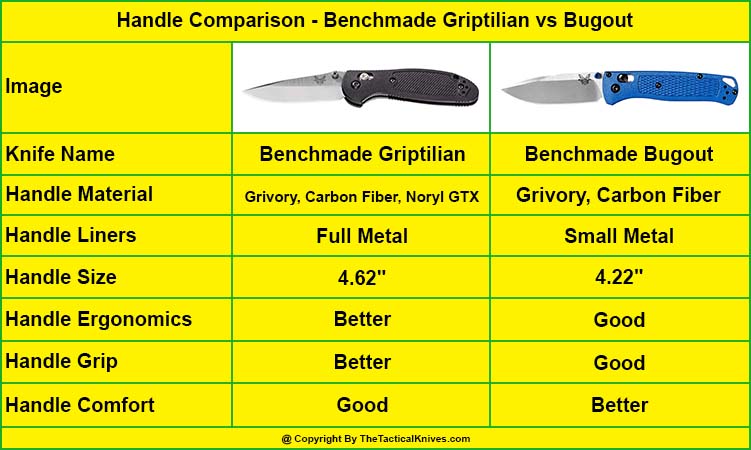
Handle Material
The Bugout’s handle comes in a couple of attractive material options: Grivory, which is infused with fiberglass, or carbon fiber infused cf-elite.
Its cousin, the Griptilian, has a handle made of Grivory and carbon fiber too. Also has Noryl GTX, which is actually a composite of two materials: polyamide and modified polyphenylene.
Handle Color
The Bugout’s handle is known for its bright colors, making it a standout in any camping pack or work bag. It comes in bright green or blue, making it especially hard to lose.
The Griptilian also comes in a variety of colors, including bright orange, but many buyers opt for its understated black version.
Handle Size
The Bugout’s handle is 4.22 inches long, while the Griptilian has a handle of 4.62 inches. These similar handle sizes make the difference in their blades more noticeable. The Griptilian’s blade is noticeably longer than the Bugout’s.
Handle Design
Griptilian’s handle is slightly longer and thicker than Bugout’s which fits big hands easily (Thickness: Griptilian 0. 64″ and Bugout 0.42” ). Both handles have an ample amount of texture.
However, the Griptilian’s handle is slightly curved and has more overall jimping, so your wet or sweaty hands will get more grip from the Griptilian. On the other hand, the curved design of the Bugout is more comfortable than the Griptilian.
Handle Strength
The fact that the Griptilian’s handle is made of a special nylon filled with glass and full steel liners inside, makes it as heavy-duty as it is attractive. However, don’t let my use of the term “heavy-duty” fool you…it is anything but heavy to carry! This handle ranks highly for its light design.
The Bugout’s handle with small liners is described as being even lighter than the Griptilian’s handle. So, in terms of strength, the Bugout’s handle features a slightly weaker design.
Handle Grip
The Bugout’s handle is designed with comfort in mind and features a textured grip that prevents the knife from sliding around in your hand.
The Griptilian, of course, has “grip” in its name, and its handle does not disappoint! Its handle is both grippier and larger than its cousin the Bugout’s, and in general, its handle grip is superior.
Handle Ergonomics
The Bugout’s handle is fairly ergonomic. However, it’s the Griptilian that gets the most rave reviews for its ergonomic handle, making it a healthy choice for any knife-savvy hand! Users compliment its ability to seemingly mold to the hand, in part due to its grippy texture. It doesn’t slide around, which contributes not only to its comfort but to its safety, too.
Handle Comfortness
The Bugout and the Griptilian both have comfortable handles when compared against their competitors on the broad knife market. However, despite their close similarities, the Bugout has a slightly more comfortable handle than the Griptilian. This is because of, you guessed it…its simple design.
Opening and Locking Mechanism
Both the knives have the same mechanism and their performance is almost the same, so there is not much difference.
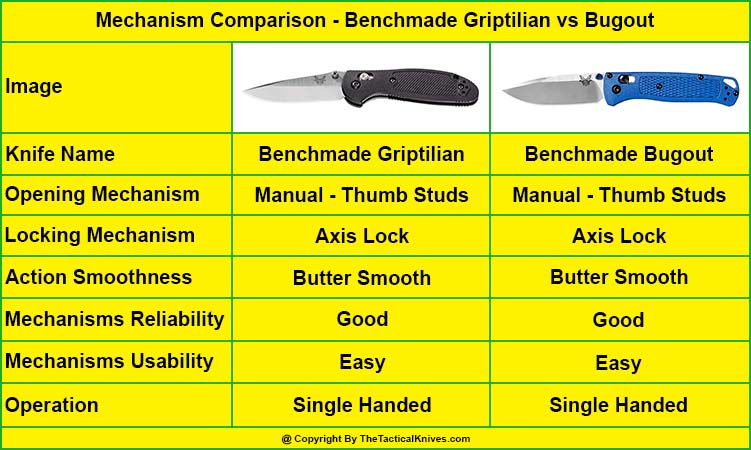
Opening Mechanism
The Griptilian’s opening mechanism consists of a single-handed thumb stud. It’s also manual, allowing for total control.
The Bugout’s opening mechanism is also thumb studs and manual, allowing it to be opened with a single hand.
Users of these two knives love that they require very minimal thumb movement in order to deploy, allowing for an extremely subtle movement. Both knife mechanisms are great for multitaskers and those who need to think and act quickly.
Locking Mechanism
The Griptilian’s locking mechanism is an Axis. The Bugout also uses an Axis locking mechanism, which locks as quickly and easily as it opens.
What’s great about this mechanism is that once you’ve opened the knife, you will get perfect blade centering and zero side-to-side blade play. While some knives open swiftly but close slowly, Benchmade’s Axis mechanism doesn’t fit this description. It locks beautifully.
Hand
Both the Bugout and Griptilian can be opened from either side, making them ambidextrous. They both get great reviews for how easy and pleasant they are to use in the hand!
Action Smoothness
The thumb studs and Axis locking mechanism make both knives extremely quick to open and close. The mechanism of the two knives is smooth as butter. That’s part of what makes these knives so lightning-quick! I give these knives a similar ranking for action smoothness. However, the Griptilian’s slightly-superior handle may enable it to produce an ever-so-slightly smoother action.
Reliability
Both the Benchmade Bugout and Griptilian are crafted to last. These are not cheap knives; they’re lifetime tools. Whether you’re camping outside or slicing boxes in a factory, both knives are very reliable. Reliability shouldn’t be a huge factor in deciding between them, because both knives should function and hold up well. Benchmade has made sure of that.
Pocket Clip
The Bugout and Griptilian both have very accessible pocket clips that can be swapped for right or left-handed carry. So don’t worry, lefties! In terms of specifics, the Bugout’s pocket clip is extremely deep and easy to hide in the pocket. The Griptilian, on the other hand, is known for having a pocket clip that is extremely strong. Both also have a convenient lanyard hole.
Price
Both knives occupy a similar price point. The Bugout usually starts at around $160 for the basic model, while the Griptilian starts at around $140. That being said, knife-hunters on a budget may find the Griptilian to provide slightly better bang for their buck. In fact, some users remark that the Bugout feels too cheap to justify its higher price tag.
Benchmade Griptilian vs Bugout – Which One to Choose and Why?
After assessing each feature these knives have to offer, you may be wondering how on earth you should choose between the Benchmade Griptilian and the Benchmade Bugout. I won’t pretend it’s easy, as both are very reputable and offer almost the same features.
However, in light of both models’ similar characteristics, the Benchmade Griptilian offers slightly better value. The fact that it arguably possesses some advantages cements this idea. For example, the Griptilian is the clear winner in the handle section, due to its durable, extra-grippy, and ergonomic handle.
Also, its size and strength make it the safest choice for outdoor and more robust tasks. Thus, while both knives are awesome, the Griptilian is the slightly superior choice – its lower price tag is just a bonus!
But if you are a light user and prefer a lightweight knife for everyday carry that requires relatively less maintenance and is easy to do, then the Bugout will be the best choice for you.
